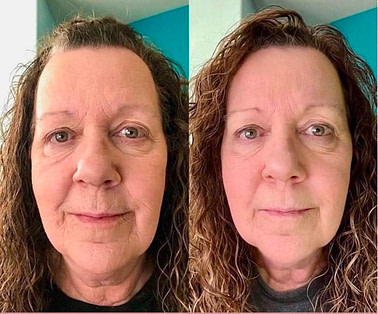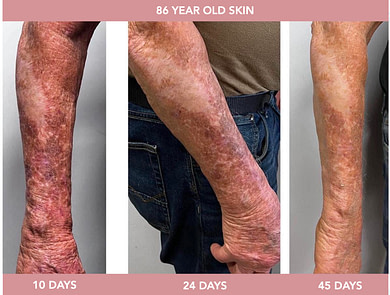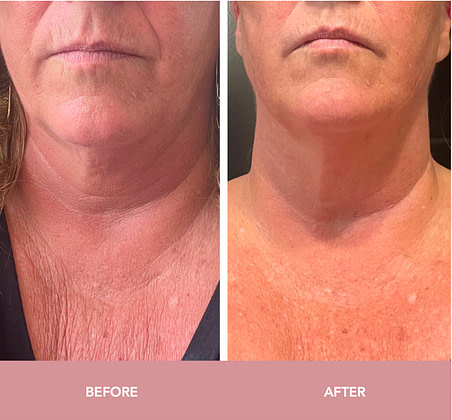Want To Glow From The Inside Out?
Your body’s ability to produce its own collagen decreases significantly starting in your 30s. This daily boost of collagen and exclusive botanicals activates your body’s collagen production, replenishes your depleting collagen levels, and maintains those levels by reducing enzymes that break down collagen.
Why Liquid Collagen?
Collagen is a structural protein that makes up about 25% - 35% of all the proteins in your body. The body produces collagen proteins from the amino acids that you take in through food.
This process starts to steeply decline around the age of 30, leading to a large reduction in collagen density which then causes saggy, dull and wrinkled looking skin.
In addition to the benefits of great looking skin, liquid collagen delivers whole body benefits:
• Nail strength
• Hair growth
• Muscle recovery
• Joint & ligament support
• Gut health
• Bone strength
• Eye health
• Liver detox
• Cardiovascular support
• Sleep quality
• Mood support
• Brain health
• Cognitive support
• Sexual health
How Liquid Collagen Works
This daily boost of collagen and exclusive botanicals activates your body’s collagen production, replenishes your depleting collagen levels, and maintains those levels by reducing enzymes that break down collagen
Activate
Ruby Quinoa Extract (Chenopodium Formosanum)
Extract from this grain unlocks the cell’s ability to absorb collagen as it activates natural collagen synthesis to reduce the appearance of fine lines and wrinkles.
Replenish
Fish Collagen Peptides
Responsibly caught fish, providing peptides from 10 different types of collagens, plus amino acids to support collagen density, elasticity, and moisture for a youthful apperance.
Maintain
Proprietary Citrus + Berry Blend
Blueberry powder, young ponkan fruit and acerola berry supply vitamin C and antioxidants to promote collagen, elastin production and help your skin create more of its own natural moisture for a healthy, glowing complexion.
Pure
Great Appleberry Flavor
Made with natural apple, cranberry, raspberry and strawberry flavors with no added sugar or artificial sweeteners. No GMO’s. No gluten. No funky aftertaste.
The 10 Types of Collagen in this Liquid Collagen
Type I
Type I is the most abundant type of collagen in the human body, accounting for approximately 90% of the body's collagen. It is a key component of skin, bones, tendons, ligaments, and other connective tissues.
It is made up of three chains of amino acids wound together in a triple helix structure. This structure provides strength and support to the tissues it forms. In skin, collagen type I provides firmness and elasticity, giving it a youthful appearance. In bones, collagen type I forms the structural framework, providing strength and support to the skeletal system.
As we age, the production of collagen type I decreases, leading to a loss of skin elasticity and bone density. This can result in wrinkles, sagging skin, and an increased risk of fractures.
Type II
Type II is a major component of cartilage, which is a flexible connective tissue that cushions and supports joints. It is also found in other tissues such as the vitreous humor of the eye and the nucleus pulposus of the intervertebral discs.
The structure of type II collagen is like that of collagen type I, consisting of three chains of amino acids wound together in a triple helix structure. However, the amino acid composition of collagen type II is different from that of collagen type I, which gives it unique properties.
Type II is essential for maintaining the health and function of joints. It provides the structural framework for cartilage, which acts as a shock absorber, reducing friction and preventing bone-on-bone contact. As we age, the production of collagen type II decreases, leading to the breakdown of cartilage and the development of conditions such as osteoarthritis.
Type V
Type V is a minor type of collagen found in small quantities in the extracellular matrix of various tissues such as skin, tendons, and bone. It is a fibrillar collagen, which means it forms fibers that provide structural support to tissues.
The structure of type V is similar to that of collagen type I, consisting of three chains of amino acids wound together in a triple helix structure. However, the amino acid composition of collagen type V is different from that of collagen type I, which gives it unique properties.
Type V is involved in the development and maintenance of tissues such as bone and skin. In bone, collagen type V helps to provide structural support, and it is essential for the mineralization of bone tissue. In skin, collagen type V is involved in the formation of the extracellular matrix, which provides support and elasticity to the skin.
Type X
Type X is a minor type of collagen that is primarily found in the growth plates of developing bones. It is involved in the process of endochondral ossification, which is the process by which cartilage is replaced by bone during bone development.
The structure of collagen type X is like that of other fibrillar collagens, consisting of three chains of amino acids wound together in a triple helix structure. However, the amino acid composition of collagen type X is unique and gives it specific properties.
Collagen type X is essential for the development and growth of bones. It is produced by chondrocytes, which are cells that are responsible for producing and maintaining cartilage. During bone development, collagen type X is involved in the transformation of cartilage into bone tissue.
Type XI
Type XI is a minor type of collagen that is primarily found in cartilage and the intervertebral discs of the spine. It is a fibrillar collagen, which means it forms fibers that provide structural support to tissues.
The structure of collagen type XI is like that of collagen type II, consisting of three chains of amino acids wound together in a triple helix structure. However, the amino acid composition of collagen type XI is different from that of collagen type II, which gives it unique properties.
Collagen type XI is involved in the development and maintenance of cartilage and the intervertebral discs. It helps to provide the structural framework for these tissues, which allows them to resist compression and provide support to the joints.
Type XVII
Type XVII, also known as BP180, is a transmembrane protein that is a component of the basement membrane zone (BMZ) of the skin and other epithelial tissues. It plays a crucial role in maintaining the integrity of the skin and other tissues by anchoring the basal layer of the epidermis to the underlying dermis.
The structure of collagen type XVII is unique compared to other types of collagen. It is a transmembrane protein, meaning it spans the cell membrane and extends into both the extracellular and intracellular spaces. It consists of a collagenous domain, which forms the anchoring fibrils that attach the epidermis to the dermis, and a non-collagenous domain, which is essential for the adhesion of the protein to the cell membrane.
Collagen type XVII is essential for the proper function and maintenance of the skin and other epithelial tissues. Mutations in the COL17A1 gene, which encodes collagen type XVII, have been associated with various autoimmune blistering diseases, including bullous pemphigoid.
Type XVIII
Type XVIII is a type of collagen that is primarily found in the basement membranes of various tissues, including blood vessels, skin, and the eye. (It is also present in some cancer cells)
The structure of collagen type XVIII is unique compared to other types of collagen. It consists of a collagenous domain, which forms a triple helix structure, and a non-collagenous domain, which is essential for its various functions. Collagen type XVIII is a multifunctional protein that is involved in many biological processes, including angiogenesis (the formation of new blood vessels), tissue development and maintenance, and cancer growth and metastasis.
Collagen type XVIII is important for maintaining the integrity and function of basement membranes, which provide structural support to tissues and help to regulate the movement of cells and molecules between different tissue compartments. It also plays a role in regulating cell proliferation and migration, which is important for tissue development and repair.
Type VIII
Type VIII is a type of collagen that is primarily found in the cornea of the eye, where it provides structural support and helps maintain the shape and transparency of the cornea.
The structure of collagen type VIII is similar to other types of collagen, consisting of three chains of amino acids wound together in a triple helix structure. However, collagen type VIII has unique properties that are specific to its function in the cornea.
Collagen type VIII is essential for the proper development and maintenance of the cornea. Mutations in the COL8A1 and COL8A2 genes, which encode collagen type VIII, have been associated with various corneal disorders, including Fuchs endothelial corneal dystrophy and posterior polymorphous corneal dystrophy.
Type IX
Type IXis a type of collagen that is primarily found in the cartilage of joints, where it plays an important role in maintaining the structural integrity and strength of the cartilage.
The structure of collagen type IX is similar to other types of collagen, consisting of three chains of amino acids wound together in a triple helix structure. However, collagen type IX has unique properties that are specific to its function in cartilage.
Collagen type IX is essential for the proper development and maintenance of healthy joints. It is a major component of the extracellular matrix of cartilage and plays a critical role in the formation of the mesh-like network of collagen fibers that give cartilage its strength and elasticity. Collagen type IX also helps to maintain the integrity of the cartilage by preventing the degradation of other types of collagen.
Type XVIII
Type XVIII is a relatively new type of collagen that was discovered in 2012. It is a member of the fibril-associated collagens with interrupted triple helices (FACIT) family of collagens, which are found in various connective tissues throughout the body.
Collagen type XVIII is primarily found in the cornea of the eye, where it plays a role in maintaining the structural integrity and transparency of the cornea. It is also present in other tissues, including the skin, cartilage, and the lining of blood vessels.
The structure of collagen type XVIII is unique compared to other types of collagen. It contains interruptions in its triple helix structure, which gives it its distinctive properties. Collagen type XVIII is thought to play a role in regulating the organization and assembly of other types of collagen fibers in the extracellular matrix.





